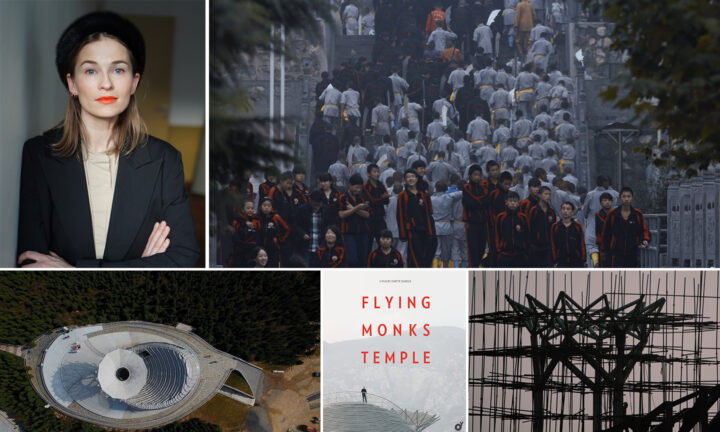Born in Riga, Žanete Skarule is currently based in Amsterdam. She holds a Master’s in Film/Video from California Institute of the Arts where she studied analogue and digital film, as well as theatre direction. In 2012 she started working in the New York-based studio of Jonas Mekas, the godfather of avant-garde cinema. In 2017 she premiered Flying Monks Temple, her debut feature documentary, which was filmed in China over the course of seven years. It tells the story of an award-winning utopian architectural installation built at the top of sacred Songshan mountain. Žanete works in documentary, fiction, and experimental film on subjects dealing with time, gender, and the relationship between city and individual. In addition to directing, Žanete is interested in curating art and film. In 2009 she started a collective space called Pērle together with fellow artists, that became a community center and a venue for performance, art, music, film, and literature in Riga. Recently, as part of the Cēsis Art festival, she curated exhibitions and screenings by, amongst others, Jonas Mekas, James Benning, and Makino Takashi.
FLYING MONKS TEMPLE_trailer from VFS FILMS on Vimeo.
Q: What does BALANCE mean to you when you think about design?
ŽS: For me, balance is the synergy of beauty and function. Concerning public space, I believe that design should go hand in hand with function. I travel often and pay attention to airports: how the logistics work, if the signs are easy to read, if there is free water available, if the chairs are comfortable in rest areas, etc. It is important that someone has put thought into details.
Finding balance is to use the resources one has in a smart way. I appreciate when limited resources are “well spent.” It is easy if there is an unlimited budget that can be invested to buy expensive design, but if that is not the case, I feel that the concept “less is more” applies in most cases. There is a saying “we are too poor to buy cheap things.” I like that idea. If the budget is limited, I’d rather have fewer things: I’d rather spend time in a nice empty space than in a space filled with low quality furniture.
When we built Pērle we had no money, but we were honest about it in the way we designed the space. We spent most of our budget on two features: a custom-made clothes rack that could be lifted up to the ceiling to free up space for dancing, and a shiny mirrored sign outside. The space itself was painted white, and filled with a few objects found in flea markets. I don’t think we always need new things. My parents have recently developed a hobby of restoring furniture. In Riga in the 2000s everyone was building something, and destroying everything that was there before. We, as a nation, wanted to be part of modern Western society and made many unconsidered and fast decisions concerning architecture. That is a damage that is hard to erase. Nowadays we have learned to appreciate more what was there before, and to let the new in while at the same time preserving some of the old.
Q: What do you predict is going to be BIG in 2019 in terms of design?
ŽS: In film, as well as other fields, things are sort of “blending.” There are more films that don’t fall under a certain genre and the borders between fiction, documentary, and experimental film are blurring. I think that it is similar in design. I think there will be more objects that don’t have a specific purpose: just beautiful things that can be used as a chair, table, lamp or as a sculpture. I also think that design and visual art are “blending.”
As for the next year, I think that “cold materials,” such as concrete, glass, stone, and metal, will continue to be used and utilized in new forms and approaches.
There will be more design dealing with issues such as global warming, looking for ways to use alternative resources and materials, reducing pollution, helping people to develop habits that can benefit our Earth in the long term. Using modern technology more specific design created to help people with special needs will develop.
Q: Tell us about a project that you worked on that you are most proud of.
ŽS: One of my most recent projects, and certainly the longest project I have ever undertaken, is my film Flying Monks Temple. It is a documentary I wrote and directed over the course of seven years. It takes place in Henan province, China, and tells the story of the creators of an award-winning utopian architectural structure: an open-air theater for flying performances at the foot of the Sacred Songshan mountain. The poetic story which emerges through one case study touches upon the subject of urbanization, and humans’ place in this process. The building was designed by Latvian architect Austris Mailītis and was commissioned by a Chinese investor Quanqi Zhu. The creators of the new building invite monks from the world-famous Shaolin Monastery nearby to participate in flying performances, and name the building Flying Monks Temple. As the process unfolds, the architect and the investor themselves have to levitate among cultural differences and conventions as attitudes towards the ambitious project differ. The Chinese investor is interested in building the object according to the Western standards, while the European architect highly values Eastern philosophy. The film draws parallels between Latvian and Chinese landscapes. There is a side story which shows another, but smaller, structure—a little sauna on a lake in Eastern Latvia which the architect is building with his family. The sauna ends up becoming a much more Zen destination for the architect than Songshan mountain, which was the birthplace of Zen philosophy.
Q: My favorite thing about my city is…
ŽS: I moved from Los Angeles to Amsterdam fairly recently. So far, the most exciting part about this city are the canals. I go to the Venice Biennale every year, and for me it is magic to be surrounded by water in a city. I didn’t know that there is such an alive water life in Amsterdam. We have a little boat and in the summertime boating is an essential part of the city experience. People are on the water early—boating, swimming, dining. The more than 100km long canals and 15,000 bridges, as well as the banks of the canals, become a center for socialization and leisure. There are several bars and restaurants where you can “park” your boat, get pizza through a little window facing the canal, and go on your way. In Riga there is a main river that is partly inaccessible. This is sad to see, because water has always provided such potential.
Q: What are your go-tos for when you’re seeking inspiration?
ŽS: Going to museums and art fairs, watching films at the movie theater, going to concerts, reading biographies—it is all inspiration, but I have realized that this kind of experience makes me think, reflect, and contemplate a lot. Sometimes, to arrive at new ideas, one has to simply clear the mind. For this purpose, surfing or going to the sauna and jumping into icy water, or just walking to the flower market and observing things around you can be very useful. Our time is so oversaturated with information and experiences that it feels more important to free space in one’s head than there is need to see and experience more.
As a teenager I believed that I’d have new perspectives only if I were to do something that no one else in my class was doing. In my case it was violin lessons, which was considered very uncool. But I still believe there is some truth in this idea. If instead of yoga I’d choose to go to Ukrainian folk dance, or make origami, I’d have a new perspective that might affect my future ideas and my future work.
Q: If you could sum up your outlook on life in a bumper sticker, what would it say?
ŽS: Take your actions seriously, don’t take yourself too seriously.
Learn more about Žanete’s work:
Instagram – @zaneteskarule
PLUS, don’t miss the upcoming screening of Flying Monks Temple at the 2019 ByDesign Festival, March 17, 5pm. Tickets and more info at bit.ly/nwbydesign.





